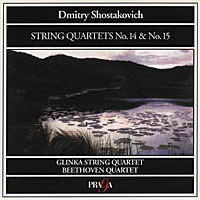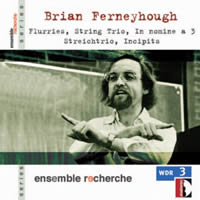Kipple 3.
|
Bart Scribner [September 2005.]
Dmitri SHOSTAKOVICH: String Quartet No. 14, Op. 142 (1973); No. 15, Op. 144 (1974). Glinka Quartet; Beethoven Quartet. Le Chant du Monde PR 7254043. Distributed in the US by Harmonia Mundi (http://www.harmoniamundi.com/). When Alex (a Ukrainian thrift-shop owner) hands me a Shostakovich CD, I pay attention; he knows his stuff. Colleague Howard Grady Brown finds this a good way to fill out Borodin I’s Chandos set of the first 13, but it’s rather more — unflinching playing of great urgency and power. Charges of deception regarding the source go well with the composer’s ethos, slippery in so many areas. Shostakovich dedicated each of quartets 11-14 to a founding member of the Beethoven Quartet, which premiered all but the first and last of the cycle. (Still, there’s no evidence he got drunk and kicked back with them, as he did with Borodin I.) Cellist Sergei Shirinsky is 14’s honoree — his S-S-H motto (E-flat, E-flat, B) turns up often, and the cello stays front and center. It initiates the dancing figures that pull the others through the opening Allegretto, if without much coordination. The viola launches a sturdy Adagio to be shared with the cello; scattered pizzicati actually extend momentum rather than stifling it fake hublot tourbillon skeleton titanium. (A typically off-kilter jauntiness undercuts the Mahlerian echoes somewhat.) The finale has the most striking invention, a ping-pong game where the melody advances from opposite sides in groups of two notes, then three, then four. Hearing these accelerating bits attain solid form is moving — when violin joins cello, Vassily Shirinsky, the band’s second violinist (Sergei’s brother) who died in 1965, comes irretrievably to mind. The Glinka Quartet (1964-78), unknown to me, was prominent enough to perform at Shostakovich’s civic funeral. Its No. 14 achieves cohesion as few have largely through volume of sound (much as Ben Webster won a draw with Tatum via sheer tone). Even its pizzicati convey size, and those isolated entrances hang together from the widest points in the soundstage. Misha Geller’s viola leads are rock steady, and cellist Dmitri Ferschman commands the required heroism. After completing No. 15, Shostakovich acted like a man on borrowed time. He asked Oleg Kagan (a brilliant violinist who would die tragically young) and his cellist wife Natalia Gutman to organize a private reading of the new quartet, with the proviso that the Beethoven Quartet not learn of it. Then during official rehearsals cellist Shirinsky died suddenly (10-18-74), and Shostakovich switched to the Taneyev Quartet for the first pair of performances. (Borodin I was inactive following the emigration and retirement of its two violinists.) Tagging the work as six consecutive adagios is accurate but misleading. Essentially a chain of farewells, it encompasses a range of manners and motion. The opening Elegy, twice the length of any other movement, can haunt one for days. The second violin’s bare, chant-like song travels through the ensemble fugally, with muted vibrato and dynamics. Serenade stomps on its beauties (ferocious strums, snapped-off cello attacks, individual crescendi that go nowhere), and the brief Intermezzo is also untethered. Violin fireworks get swallowed by a droning cello — an arresting intro over an abyss. Nocturne and Funeral March likewise unravel after promising starts. A cinematic montage of earlier events, Epilogue is a cleverly speeded-up digest of the whole (the violin gymnastics wipe out the chant). The lights grow dimmer, and a step into the void arrives without drama. Violinist Dmitri Tsiganov was the prime force in the Beethoven Quartet’s formation in 1923 (15 years before Shostakovich’s No. 1). In 1975 he was the only one of the first foursome still active. Whether he thought of past and present mates, the playing here is of his best — securely bowed in still sections, yet ready to unleash a display when called upon. And new cellist Yevgeni Altman sports a bold, confident tone and splendid fit. The composer had this bunch in his head while creating, so this is the place to start with No. 15, and probably to stop as well. Through simultaneous playback, keen-eared W. Mark Roberts of DSCH Journal determined the recording of No. 15 is not a 10-18-76 Czech Radio tape, but a dub off the Soviet LP. Since this essential rendition was available only in a mediocre CD transfer around 1994, I’m delighted the pirate issue lives on.
I seldom grant ad hoc celeb quartets much credence, but a 7-29-82 Kagan / Zhislin / Bashmet / Gutman go at No. 15 (Live Classics LCL 110) could be ripping, in view of their history with it. For those of us who don’t want the Elegy adagio to end, Kagan et al. stretch it to 15:07, or 2:35 longer than the Beethovens. The editor’s appreciation of Borodin I’s Chandos box is here.
Brian FERNEYHOUGH: Flurries (1997), String Trio (1995), In Nomine a 3 (2001), Streichtrio (1994), Incipits (1997). ensemble recherche. Stradivarius STR 33694 (http://www.stradivarius.it/). Recently I swapped a fine pallbearer’s suit for a Tower Records credit. This is the first from that haul, not that I’m a dedicated Ferneyhovite. I admire several earlier pieces with embedded layering, but the “guru of New Complexity” guff means zip. The stuff scans or it doesn’t — process won’t buy you dinner. Alessandro Melchiorre’s annotations fill ten pages and often adopt the overchewed, cranky tone of the composer’s worst side. Curiously, he seems bent on proving Ferneyhough’s importance, which I’d have thought beyond dispute. (The flag in the sand was the 1967 Sonatas for String Quartet, which I still enjoy.) Melchiorre uses the labyrinth as Ferneyhough’s expressive model, hardly a fresh idea. For me the grid makes better sense — “a net to catch significance,” a sharp student termed it. Grids serve in principle across the board here. Great string trios of the past (Mozart’s K. 563, Beethoven’s Op. 9, Schoenberg’s Op. 45, Schnittke’s 1985 masterpiece) have a distinct Viennese flavor. None of that affects Ferneyhough. He assigns a set of characteristics to each instrument — violin “voluble and extroverted,” viola “rigidity, hesitation and fragility,” cello “lyrical and meditative.” Each of these is commented on by the others and amplified, then the trio addresses four contrasting episodes. Only the third, Largo desolato, is recognizable. Naturally (with Ferneyhough) events occur at a speed that obscures these templates in a welter of details — bow touches, insectile buzzes, murmurs, rustlings, sawings. That 25 minutes of this retains its grip commends Ferneyhough’s mastery of color, drama and silence. Traditional virtues, never mind the complexity angle. This 1995 effort is among his strongest ever. Flurries and Incipits (both 1997) are much slighter because wholly arbitrary. In the former, three duos (violin / cello, clarinet / piano, piccolo / horn) each on different material are transformed into trios (piano and strings, three winds). The development is earthbound, with much overuse of glissandi to maintain a slithering motion. Incipits slaps together seven beginnings that propose various approaches, none of which leaves the garage. Two trifles are more engaging. Streichtrio (1994) was a gift to electronic-studio wizard André Richard on his 50th birthday. In keeping with the machine aura, Ferneyhough wrote it on an IRCAM software program. (He’s an ink-on-paper guy.) In Nomine a 3 (2001) presents a fragment of the plainchant theme in whole notes, then permits glimpses through “windows” in the accompaniment — a technique he exploited in Lemma-Icon-Epigram (1981) and Kurze Schatten II (1983-89). Alas, Melchiorre is incorrect about the origin of all those In Nomine fantasias — it’s the Gloria tibi Trinitas mass by John Taverner (c. 1495-1545), not Christopher Tye (c. 1505-1572). Tye penned more fantasias on the subject than anyone, and Hespèrion XX / Savall put the 31 on their Lawdes Deo disc, now a midprice Naïve ES 9939 — one of the peaks of the viol-consort catalog. Not being Ferneyhough, one of the handful of musicians to have done these or an acolyte like Richard Toop, I’ve no exact idea how this CD ought to go. It was a West German Radio 3 concert in 2002, for which ensemble recherche no doubt prepared as well as time allowed. Their String Trio is a slightly scrappy 22:12 compared to the score’s timing. Similarly, the sound is impressive only if one doesn’t peer too intently. Unplugged Any fan of battery-powered stereo gear should applaud Red Wine Audio’s emergence. A natural outgrowth of Vinnie Rossi’s mods and tweaks, it’s garnered enviable notices in recent months (see below). So far two passive preamp / 6 wpc power amp combos are notable (the Lotus duo and the Puri-T / Clari-T); the amps boast many customizing options. With my phones-only rig, I’m intrigued by the Monica 2 non-oversampling DAC and special cables, and a battery CD transport is on the way. Prices are beneath reasonable. See reviews from 6 Moons here and here. The Red Wine Audio website is here.
[More Bart Scribner, Kipple]
[More
Ferneyhough, Shostakovich]
[Previous Article:
“Presque Fin”: Ferrari Almost Final]
[Next Article:
Boulez: A Master Speaks Anew]
|



